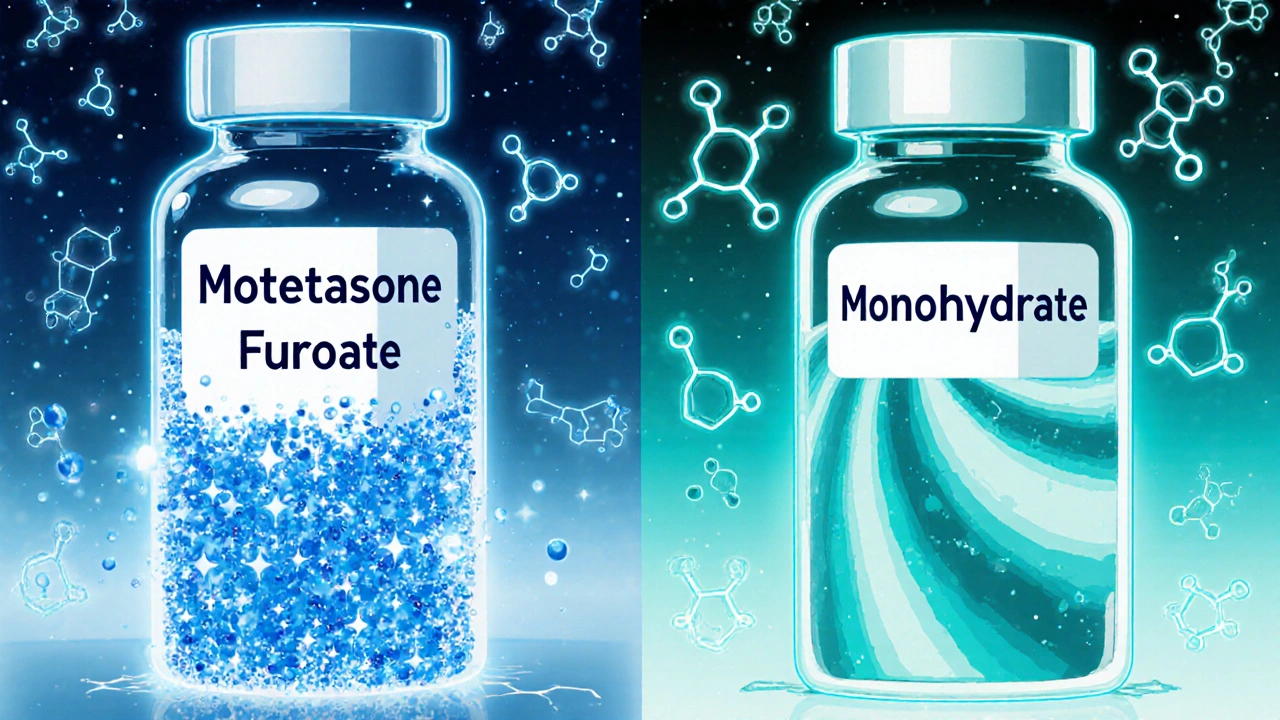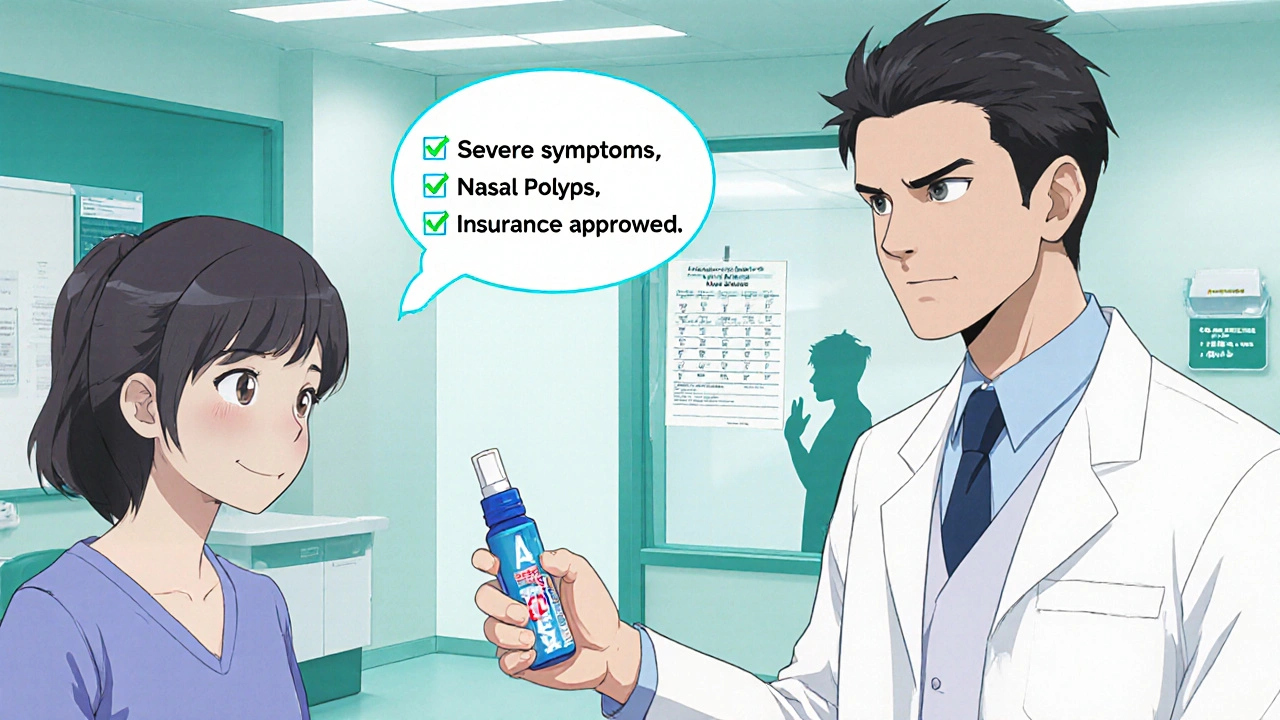Nasal Spray Recommendation Tool
Answer a few quick questions to find the best nasal spray for your situation. This tool helps you consider symptom severity, budget, insurance coverage, and specific medical conditions.
When it comes to battling seasonal sneezes, post‑nasal drip, and that constant stuffy feeling, many people reach for a nasal spray. Nasonex nasal spray often tops the list, but the market is crowded with other steroid options and even some non‑steroid solutions. This guide walks you through the two Nasonex formulations-furoate and monohydrate-then lines them up against the most common alternatives so you can see which one fits your symptoms, budget, and lifestyle best.
What makes Nasonex different?
Nasonex nasal spray is a prescription‑only intranasal corticosteroid that contains mometasone, a potent anti‑inflammatory agent. The brand offers two distinct salts: mometasone furoate and mometasone monohydrate. Both deliver the same active molecule, but the salt form changes how quickly the drug dissolves, how stable it is in the bottle, and, in subtle ways, how you feel after a few weeks of use.
Formulation showdown: Furoate vs. Monohydrate
- Mometasone furoate - The most common salt in the U.S. market. It’s highly soluble, which means each spray delivers a very precise dose (50 µg per actuation). The furoate version tends to stay stable longer, making it a good choice for people who refill their bottles less often.
- Mometasone monohydrate - Slightly less soluble, which can lead to a marginally slower onset of relief. Some clinicians note a gentler sensation in the nasal lining, which may matter for sensitive users.
Both versions are approved for treating allergic rhinitis, nasal polyps, and even non‑allergic rhinitis. The clinical efficacy gap is tiny-studies show 80‑85 % of patients report symptom reduction within two weeks, regardless of the salt.
How do they compare with the big players?
| Product | Active ingredient | Salt/Form | Prescription? | Typical dose (sprays/day) | Average monthly cost (USD) |
|---|---|---|---|---|---|
| Nasonex (furoate) | Mometasone | Furoate | Prescription | 1-2 | $30‑$45 |
| Nasonex (monohydrate) | Mometasone | Monohydrate | Prescription | 1-2 | $30‑$45 |
| Flonase | Fluticasone propionate | Propionate | Over‑the‑counter (OTC) | 2 | $15‑$25 |
| Rhinocort | Budesonide | Pure | Prescription (but OTC in some regions) | 1-2 | $20‑$30 |
| Nasacort | Triamcinolone acetonide | Acetonide | OTC | 2 | $12‑$20 |
| Beclomethasone dipropionate | Beclomethasone | Dipropionate | Prescription | 2 | $25‑$35 |
The table makes a few things clear at a glance: Nasonex sits at the higher‑price end, but it also packs a stronger anti‑inflammatory punch. Flonase and Nasacort win on affordability and OTC convenience, while Rhinocort and Beclomethasone sit somewhere in the middle.
When to choose Nasonex (furoate or monohydrate)
- Severe or chronic symptoms. If you’ve tried OTC options and still wake up with a blocked nose, stepping up to a prescription‑strength steroid can cut inflammation faster.
- Diagnosed nasal polyps. Mometasone has FDA approval for shrinking polyps, something most OTC sprays can’t claim.
- Allergy‑triggered asthma. Reducing nasal inflammation often helps lower asthma flare‑ups, and Nasonex’s potency is useful here.
Both salts work for these cases; the choice between them usually comes down to physician habit or insurance formulary preferences.

When OTC alternatives might be enough
- Seasonal allergies that are mild to moderate. Flonase and Nasacort deliver enough steroid to calm most summer hay fever without a prescription.
- Budget constraints. The cost difference adds up-$30 per month for Nasonex vs. $15 for Flonase can be a deciding factor.
- Desire for easy access. No doctor visit, no insurance paperwork-just walk to the pharmacy and pick up an OTC spray.
Side‑effect profile: what to watch for
All intranasal corticosteroids share a core set of potential issues: nasal dryness, occasional nosebleeds, and a slight risk of local fungal growth if you use them long‑term without proper hygiene. However, the rates differ slightly.
| Product | Dryness / Irritation | Nosebleed incidence | Systemic absorption (very low) |
|---|---|---|---|
| Nasonex (both salts) | Low‑moderate | 2-4 % | ≤0.5 % |
| Flonase | Moderate | 3-5 % | ≈0.6 % |
| Rhinocort | Low | 1-3 % | ≈0.4 % |
| Nasacort | Higher | 4-6 % | ≈0.7 % |
In practice, the differences are subtle. Most users experience minimal irritation if they follow the simple rule: spray once, then gently blow the nose after a minute.
Insurance and availability considerations
Because Nasonex requires a prescription, you’ll need a doctor’s note and possibly prior authorization from your insurer. Many Canadian provincial plans list Nasonex as a Tier 2 drug, meaning a modest co‑pay. In the U.S., Medicare Part D often covers it, but the out‑of‑pocket cost can rise to $70 if your plan has a high deductible.
OTC alternatives bypass these hurdles entirely, but they may be restricted in bulk purchases-some insurers cap the quantity you can claim reimbursements for.

Practical tips for getting the most out of any nasal spray
- Prime the bottle. Especially with Nasonex, shake gently and spray a few times into the air before the first dose.
- Correct positioning. Tilt your head slightly forward, close one nostril, and aim the nozzle toward the outer side of the opposite nostril. This maximizes coverage of the turbinates.
- Avoid over‑use. More isn’t better; stick to the prescribed number of sprays. Excess can increase dryness and nosebleeds.
- Combine with saline rinse. A daily salt‑water rinse helps clear mucus and reduces irritation from steroid sprays.
- Monitor symptom progress. Give each product at least two weeks before deciding it isn’t working-most studies show peak benefit at day 14.
Key takeaways
- Nasonex (both furoate and monohydrate) offers the strongest anti‑inflammatory effect among nasal steroids, ideal for severe or chronic allergic rhinitis and nasal polyps.
- Flonase and Nasacort provide effective relief for mild‑to‑moderate allergies at a lower price and without a prescription.
- Side‑effects are generally mild and similar across products; proper technique minimizes risks.
- Insurance coverage can swing the cost balance-check your formulary before committing.
- Consistent use, correct spray technique, and occasional saline rinses boost any spray’s performance.
Frequently Asked Questions
Can I use Nasonex and an antihistamine together?
Yes. Combining a nasal steroid with an oral antihistamine tackles both inflammation and histamine‑driven itching. Most doctors recommend taking a non‑sedating antihistamine like cetirizine alongside Nasonex for comprehensive relief.
How long does it take for Nasonex to start working?
Patients usually notice a reduction in congestion within 24‑48 hours, but full symptom control often requires 7‑14 days of consistent twice‑daily use.
Is it safe to use Nasonex during pregnancy?
Category B evidence suggests limited risk, but you should discuss any steroid use with your OB‑GYN. Many clinicians prefer OTC options during pregnancy unless symptoms are severe.
What’s the difference between a prescription and OTC nasal steroid?
Prescription sprays like Nasonex often have higher potency and are approved for additional indications such as nasal polyps. OTC sprays are slightly lower in strength but still effective for everyday allergy relief.
Can I switch from Flonase to Nasonex without a break?
Yes. You can transition directly; just follow the dosing schedule of the new product. Some people experience a brief adjustment period, but it’s generally safe.
Next steps
If you’ve identified that Nasonex’s power aligns with your symptom severity, schedule a brief telehealth visit to get the prescription and check whether your plan covers it. If cost is a concern, try an OTC spray for a couple of weeks; note the difference in symptom control, then decide if a prescription upgrade is worth it.
Remember, consistent technique and a simple saline rinse can turn even a modest spray into a powerful ally against allergy misery.

14 Comments
Nasonex’s potency makes it a solid option for patients with severe, chronic nasal inflammation, especially when OTC sprays fall short. Its prescription status ensures consistent dosing under medical supervision.
While many praise Nasonex, one should remember that higher potency also brings a higher risk of local side effects; the marginal benefit over Flonase is debatable. Consider the cost‑benefit ratio before committing.
Wow!!! Nasonex really packs a punch, but don’t ignore the tiny chance of nosebleeds!! If you’re sensitive, the monohydrate might feel gentler!!! Still, the furoate’s quick dissolve can be a game‑changer!!!
Great breakdown! For anyone on a budget, trying Flonase first is a smart move. If symptoms persist, stepping up to Nasonex under a doctor’s guidance is the next logical step.
When evaluating Nasonex versus its over‑the‑counter counterparts, one must first acknowledge the pharmacodynamic superiority inherent in a prescription‑only corticosteroid. The mometasone molecule, regardless of its salt form, offers a higher affinity for glucocorticoid receptors within nasal mucosa, thereby attenuating the inflammatory cascade more efficiently. Moreover, the furoate salt’s heightened solubility ensures a rapid onset of action, often noticeable within the first 24‑48 hours of consistent use. In contrast, the monohydrate’s slower dissolution may afford a gentler experience for patients with delicate nasal epithelium, albeit at the expense of a marginally delayed therapeutic effect. Clinical trials have consistently demonstrated an 80‑85 % response rate within two weeks, a statistic that eclipses most OTC formulations whose efficacy hovers around 60‑70 %. Cost considerations, however, remain non‑trivial; the monthly expenditure for Nasonex frequently doubles that of fluticasone‑based sprays, a factor that insurers may partially offset but not always fully. Insurance navigation can be labyrinthine, with prior authorizations and tiered formularies dictating patient access. From a safety perspective, the side‑effect profile of Nasonex is comparable to its peers, with nasal dryness and occasional epistaxis reported in a small minority of users. Proper technique-priming the pump, aiming laterally, and following each dose with a gentle nasal blow-mitigates these risks appreciably. Adjunctive saline irrigation further enhances mucosal hydration, curbing irritation while promoting drug distribution. For individuals battling nasal polyps or asthma‑linked rhinitis, the anti‑inflammatory potency of Nasonex can translate into meaningful clinical improvement beyond mere symptom palliation. Ultimately, the decision hinges upon disease severity, patient tolerance, and financial feasibility, each weighted according to individual circumstance.
Nasonex works well but watch out for insurance hoops. It’s stronger than Flonase, so you might need a doctor’s note.
Our nation deserves the best care, and Nasonex delivers that power. If you’re feeling the pin‑prick of mild sprays, step up-your health is worth it.
Here’s a quick tip: always prime the Nasonex bottle before the first use and combine it with a daily saline rinse. This routine maximizes drug delivery and minimizes dryness, leading to faster relief.
Use Nasonex twice daily as prescribed; avoid exceeding the recommended dose to prevent irritation.
Clinical efficacy of mometasone is superior due to higher receptor affinity.
Despite the allure of prescription potency, one must critically assess whether the incremental benefit justifies the elevated expense and potential for adverse effects.
In the grand tapestry of nasal therapeutics, the choice between furoate and monohydrate reflects a subtle balance between immediacy and gentleness, inviting patients to contemplate not only symptom relief but also the philosophy of medical intervention.
If you’re new to nasal steroids, start with a low‑dose regimen and monitor for dryness. Consulting a pharmacist can also help personalize your approach.
Everyone’s talking about how the pharma giants push Nasonex for profit, but the real scoop is that a simple saline rinse can give you almost the same relief without any hidden agendas.
Write a comment